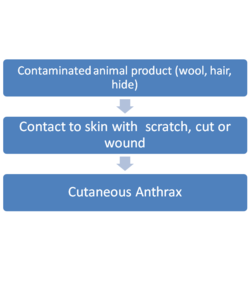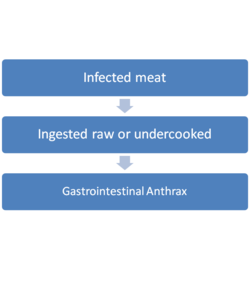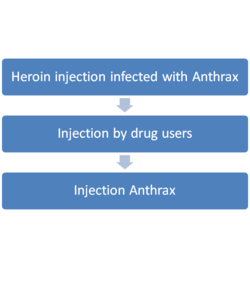Anthrax: Difference between revisions
No edit summary |
No edit summary |
||
| Line 34: | Line 34: | ||
== Risk Factors == | == Risk Factors == | ||
Occupational hazard for | Occupational hazard for: | ||
* Veterinarians | |||
* Farmers | |||
* Individuals who handle animal wool, hair, hides, or bone meal products.<ref name=":1" /> | |||
* Travelers | |||
* Laboratory professionals | |||
* Mail handlers, military personnel, and response workers who may be exposed during a bioterror event involving anthrax spores<ref name=":0" /> | |||
* | |||
There is no racial, sexual, or age predilection for anthrax. However, because anthrax is often related to industrial exposure and farming, the disease most often affects young and middle-aged adults.<ref name=":1" /> | There is no racial, sexual, or age predilection for anthrax. However, because anthrax is often related to industrial exposure and farming, the disease most often affects young and middle-aged adults.<ref name=":1" /> | ||
Revision as of 04:29, 2 April 2020
This article or area is currently under construction and may only be partially complete. Please come back soon to see the finished work! (2/04/2020)
Definition[edit | edit source]
Anthrax is an acute zoonotic disease caused by the spore-forming bacterium Bacillus anthracis, a microbe that lives in the soil.[1]
- A serious infectious disease caused by gram-positive, rod-shaped bacteria known as Bacillus anthracis.[2]
- Anthrax can be found naturally in soil and commonly affects domestic and wild animals around the world.[2]
- Rare in the United States - people can get sick with anthrax if they come in contact with infected animals or contaminated animal products.[2]
- Contact with anthrax can cause severe illness in both humans and animals.[2]
- Anthrax is not contagious, which means you can’t catch it like the cold or flu.[2]
- Anthrax can occur in four forms: cutaneous, inhalation, gastrointestinal, and inhalation.[2]
Clinically Relevant Anatomy[edit | edit source]
Anthrax can affect different body systems, depending on the route of infection. It can affect the integumentary system, gastrointestinal/ digestive system and respiratory system.
Etiology[edit | edit source]
The pathogen that causes Anthrax is a bacterium known as Bacillus anthracis.
Epidemiology[edit | edit source]
Most cases of anthrax are cutaneous (95%); the remaining cases are inhalation (5%) and gastrointestinal (< 1%).[3] Injection Anthrax have only been reported in Northern Europe.[4]
Incidence of any anthrax infection has been less than 1 case per year in the US for the last 30 years. From 1955–1994, US cases totaled 235, with 224 cases of cutaneous anthrax, 11 cases of inhalation anthrax, and 20 fatalities.[3]
Anthrax is common in Middle East, the Indian subcontinent, Africa, Asia, and Latin America and is rare in Western Europe. In 1958, approximately 100,000 cases of anthrax occurred worldwide. Anthrax is endemic in Africa and Asia despite vaccination programs.[3]
In 1978, during the Rhodesian civil war, failure of veterinary vaccination programs led to a human epidemic, causing 6500 anthrax cases and 100 fatalities.[3]
In October 2001, 22 cases of anthrax infection were identified.[3] Most recently in 2016, in Siberia, Russia, there was an outbreak of anthrax that affected at least 13 Siberian people and killed over 2,000 reindeer.[4]
Risk Factors[edit | edit source]
Occupational hazard for:
- Veterinarians
- Farmers
- Individuals who handle animal wool, hair, hides, or bone meal products.[3]
- Travelers
- Laboratory professionals
- Mail handlers, military personnel, and response workers who may be exposed during a bioterror event involving anthrax spores[2]
There is no racial, sexual, or age predilection for anthrax. However, because anthrax is often related to industrial exposure and farming, the disease most often affects young and middle-aged adults.[3]
Pathophysiology[edit | edit source]
Anthrax can occur in four different forms, depending on the route of infection.

|

|

|

|
Clinical Presentation[edit | edit source]
Cutaneous Anthrax
Gastrointestinal Anthrax
Inhalation Anthrax
Injection Anthrax
Diagnostic Procedures[edit | edit source]
Outcome Measures[edit | edit source]
Management / Interventions[edit | edit source]
Differential Diagnosis[edit | edit source]
Resources[edit | edit source]
References[edit | edit source]
- ↑ U.S. National Library of Medicine. National Institute of Health. Medline Plus. Anthrax.http://www.nlm.nih.gov/medlineplus/anthrax.html (accessed 2 March 2011)
- ↑ 2.0 2.1 2.2 2.3 2.4 2.5 2.6 CDC- Anthrax- Basic Information. Available at https://www.cdc.gov/anthrax/basics/index.html (Accessed March 30, 2020)
- ↑ 3.0 3.1 3.2 3.3 3.4 3.5 3.6 Medscape- Anthrax. Available at https://emedicine.medscape.com/article/212127-overview (Accessed March 31, 2020)
- ↑ 4.0 4.1 Medicinenet- Anthrax. Available at https://www.medicinenet.com/anthrax/article.htm#anthrax_facts (Accessed March 31, 2020)






